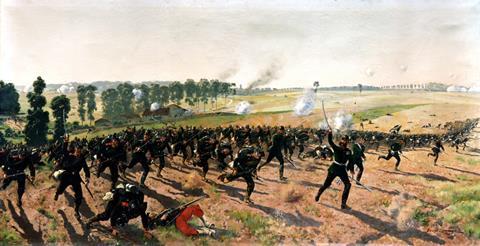As far as I am aware, no member of SfAM (now AMI) has ever been honoured by having a beer named after them; something I find quite surprising in view of the heroic contribution many have made in support of the brewing industry over the years.
Louis Pasteur, however, was more fortunate, with 100 bottles of Louis Pasteur Ale produced by the Whitbread brewery in 1995 to mark the centenary of his death. The brewery in Chiswell Street, adjoining the Barbican, had particular reason to commemorate his passing as, to quote their head of R&D speaking in 1967, ‘We like to think that our scientific tradition stems from the time when Pasteur was here and persuaded the company to buy a microscope’.
Pasteur had started studying the brewing process, prompted by the humbling defeat of France in the Franco-Prussian War of 1870–1871. An ardent patriot, he felt that defeat had been due, in part, to Prussian technical superiority. One aspect of this, he recognised, was in brewing; a problem that had been further aggravated by the loss of Alsace and Lorraine (France’s major hop-growing and brewing region) as a result of the war. To assist in his nation’s recovery, Pasteur began a programme of research at the Kuhn brewery in Chamalières, near Clermont-Ferrand, and in June 1871 he patented an improved method of brewing, based largely on the exclusion of atmospheric contamination. Beers produced following his precepts were to be described as bières de la revanche nationale – beers of national revenge. The Kuhn brewery was very small and Pasteur wanted to visit some of the large concerns in England to see their practices and how they related to his work. To this end he travelled to London with his son in September 1871, staying at the Grosvenor Hotel at Victoria Station. On 9 September, they ventured out to the Whitbread brewery in Chiswell Street – the only brewery visit there seems to be a record of.

At the time, London was a major brewing centre and Whitbread, founded by Samuel Whitbread in 1742, had been one of its largest concerns for more than a century. The Chiswell Street brewery was built in 1750, specifically designed for the production of Porter – the first industrial beer, benefiting from production on a very large scale. Porter has already been described in this column in connection with the Great Beer Flood of 1814, caused by the bursting of huge vats used to store the beer during its maturation. Whitbread used similar vats but he also spent considerable time and energy converting underground vaults, previously used to store casks, into large cisterns for Porter maturation. Conversion did not prove entirely straightforward, taking nearly 10 years to make the vaults effectively watertight.
The first attempts employed Robert Mylne, the architect of Blackfriars Bridge, who, despite confidently declaring that he was prepared to stand under the vaults when first filled, was ‘let go’ when they leaked like a sieve. He was followed by John Smeaton, the world-renowned civil engineer responsible for, among other things, the design of the third Eddystone Lighthouse. He suggested York stone slabs and a resistant cement of rosin, beeswax and sand, which unfortunately was found to have little resistance to the corrosive powers of Porter. Whitbread wrote to the potter Wedgwood, enquiring about the use of glazed tiles, ship’s caulkers were employed to make the joints watertight, tinned copper plates were put over angles and iron ties, and buttresses were installed to resist the pressure on the walls. It wasn’t until 1784 that he finally succeeded.
The completed cisterns could hold 12,000 barrels (nearly three million litres) and Whitbread named two of them the King’s Vault and the Queen’s Vault following a Royal visit in 1787, commemorated by a wall plaque surviving to this day. Despite the numerous setbacks, the exercise was declared a success since the ability to mature Porter in even larger volumes achieved greater uniformity and improved the quality of the beer produced. Whitbread was a noted technical innovator in other ways, being the second brewer in London to install a Boulton and Watt steam engine in 1784, only 2 years after the introduction of rotative steam power.

During his visit, Pasteur toured the brewery and examined samples of yeast using a microscope he had brought with him. It appears that he did not like beer very much and was not a good judge of its sensory properties. However, looking at a sample of Porter yeast, he recognised and drew an infecting organism, declaring that surely this Porter must leave much to be desired and that the presence of the contaminant must have betrayed itself by some sensory defect. It was admitted that this was the case and that fresh yeast had been bought in from another brewery. On examination he declared the fresh yeast to be much better, unlike other samples he examined of yeast from ale fermentations and finings used to clear the beer. Though some other breweries in the UK were using microscopes at this time, Whitbread was not. When Pasteur returned a week later, he found that a binocular microscope had been bought, costing £27 15s (£27.75).
Brewing at Chiswell Street ceased in 1976 and Whitbread sold its pubs and breweries in 2001. Several brewery buildings remain as part of the Montcalm Hotel and, across the street and below ground, the cisterns are still in use, now as ‘event spaces’. Whitbread plc is now a ‘hospitality’ company operating hotels and restaurants. Its website declares its vision ‘to grow its brands by building a strong customer heartbeat’. One can speculate whether it was concerns about ‘customer heartbeat’ that prompted their 2018 sale of the Costa Coffee chain to Coca-Cola.







No comments yet